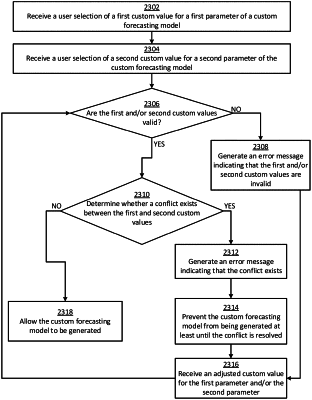| CPC G06N 3/044 (2023.01) [G06F 3/04847 (2013.01)] | 30 Claims |

|
1. A system comprising:
one or more processors; and
one or more memory devices including program code that is executable by the one or more processors for causing the one or more processors to:
receive a first selection, from a user, of time series data to be used in a forecasting project;
receive a second selection, from the user, of a type of forecasting model that is to be applied to the time series data in the forecasting project from among a plurality of types of forecasting models;
based on receiving the first selection and the second selection:
obtain a first set of candidate values for a first parameter of the selected type of forecasting model, the first set of candidate values being determined based on statistical information derived from the time series data;
obtain a second set of candidate values for a second parameter of the selected type of forecasting model, the second set of candidate values being determined based on the statistical information; and
provide the first set of candidate values and the second set of candidate values for output to the user;
receive selections, from the user, of a first parameter value from among the first set of candidate values and a second parameter value from among the second set of candidate values;
subsequent to receiving the selections and prior to generating the selected type of forecasting model, determine that a conflict exists between the first parameter value and the second parameter value, the conflict corresponding to an operational problem with the selected type of forecasting model, the conflict being determined by applying a set of conflict rules to the first parameter value and the second parameter value; and
based on determining that the conflict exists, generate an output indicating that the conflict exists between the first parameter value and the second parameter value.
|